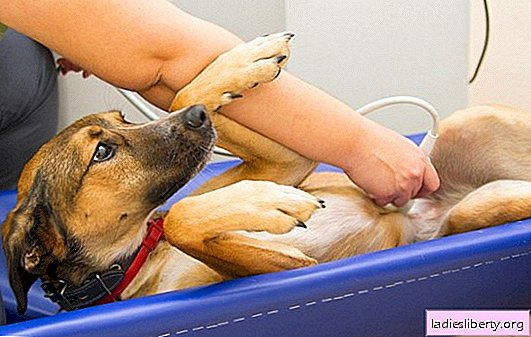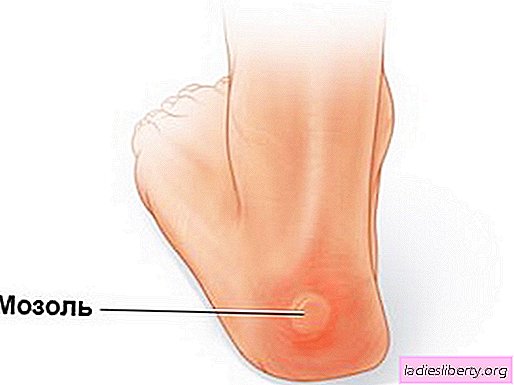
Rabies is a disease that severely affects the nervous system of an animal. It is viral and always ends in death for infected dogs. It can be transmitted to a pet after contact with a wild animal (for example, a fox or a raccoon - carriers of rabies) or from other infected stray relatives.
The disease cannot be cured, so individuals affected by it should be eradicated immediately. This will avoid the spread of the disease.
General information on rabies and its etiology
The disease is excited by a neurotropic virus belonging to the Rabdovirus family. The virus is street (circulating in a natural environment for animals) and fixed (with its help receive rabies vaccines). It quickly loses its activity at high temperatures, but has resistance to low. It is destroyed by lysol and chloramine (their 3% solutions).
Rabies refers to zoonotic infections caused by wild animals. Carnivores include foxes, wolves, skunks, jackals, bats, mongooses. They can transmit the virus to your pet by biting or getting saliva on the mucous membrane (which is a rarer case).
Incubation period
The incubation period is affected by the localization of the bite: the closer it is to the head, the shorter it lasts. So, its duration can take from 10 days to 3 months. Cases of the incubation period of about a year or more are not excluded.
When it is characterized by the presence of the pathogen in the area of its entry and the gradual penetration of the brain. During the incubation period, rabies in dogs does not show symptoms at all, so you can notice them only with the progression of the disease.
Symptoms of various forms of the disease
There are five different forms of rabies that occur after the end of the incubation period: violent (has three stages of progression), silent, recurrent, abortive (officially there are only a few cases of this form) and atypical. Each of them is characterized by its symptoms.
Violent form of rabies
It is the most common and proceeds in three stages:
1. Prodromal stage lasts for three days. The animal has a lethargic, apathetic state, in which it either seeks a nook and stops responding, or displays an unusual affection. At this time, the dog is especially contagious, as the level of virus isolation by it is very high. You can watch her grabbing air with her mouth, swallowing movements are difficult, drool begins to flow.
2. Manic stage takes the same amount of time. It is accompanied by aggressive behavior of the pet in relation to the owner, violent grabbing the mouth of inedible objects. At this stage, salivation is especially intensified, turning into foam. The mood in a dog can be changeable: from aggressive behavior it can dramatically turn into apathetic and vice versa.
3. Paralytic stage is final. And its outcome is always fatal. Lasts up to a week, characterized by complete paralysis of the hind limbs of the dog. The animal can no longer drink and eat, eventually falling into a coma and dying.
Silent form of rabies
It also occurs frequently and occurs with a good appetite in the dog, it does not refuse to drink, but it becomes difficult to swallow. Aggression is not observed, but coordination problems arise - the animal moves uncertainly, as if staggering. Drooling is very active, the dog begins to nibble on inedible objects. After a couple of days, the hind limbs and pharynx are paralyzed. The lower jaw is also taken away. Death occurs 3-5 days after the end of the incubation period.
Recurrent form of rabies
With the return form, rabies symptoms in dogs are paroxysmal. A vivid manifestation of the disease occurs in a very aggressive form, but then disappears, attacking again in an enhanced form. Such attacks can last a couple of days until death, however, there are cases when the animal takes a break between the next attack for weeks.
Abortive form of rabies
It is found less frequently than all the others, therefore it has not yet been fully studied. In another way, it can be called a miracle, because the disease itself recedes already at the second stage of progression. Officially, only a few such situations were registered.
Atypical form of rabies
Atypical form lasts a very long time - from 3 to 6 months. The dog thus becomes weaker, the symptoms of its condition are completely uncharacteristic of the most common signs of rabies. They are more like gastroenteritis - the dog suffers from diarrhea and often pulls out. It is depleted and eventually dies.
How to determine rabies in a dog
The main symptoms of rabies in dogs are in its appearance: it is as if thinned, saliva is actively released, the tongue falls out, the cornea becomes cloudy, the eye pupils are not equally directed. The further course of the disease paralyzes the hind legs, after the heart and respiratory muscles, which causes death.
For an accurate diagnosis, it is important to distinguish rabies from the nervous form of the plague (in this case, paralysis and epileptic seizures occur, but the lower jaw never paralyzes), encephalitis, Aujeszky’s disease (itching and scratching, and aggression is manifested only in relation to foreign objects and animals but not to people).
Disease prevention
Since rabies is incurable, timely vaccination is the only way to protect your pet. The first rabies vaccine is given to a puppy at the age of 3 or 6 months (when the teeth have already changed). The procedure should be repeated annually, and its time should be the same. Now the vaccination can be carried out by the state veterinary station on a free basis.
Rabies is a very dangerous disease for dogs that can rob you of your pet. Therefore, do not allow contact between him and wild or stray animals. This will save the dog and you from further complications.











